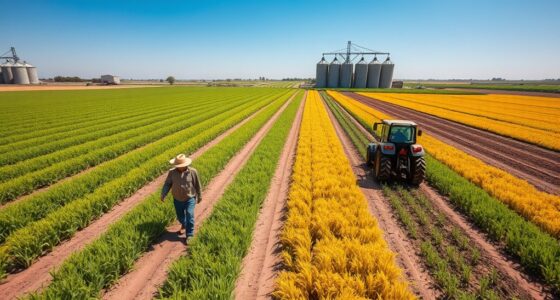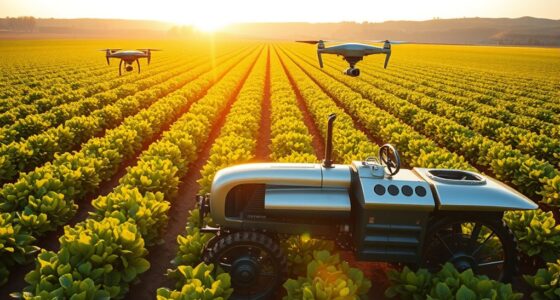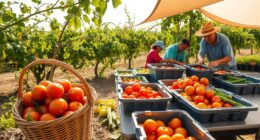Tenant farming began after the Civil War as a solution for landless farmers, often rooted in cycles of dependency and historical inequalities. It involves landowners and tenants sharing crops or rents, but challenges persist, like rising costs and market instability. Sharecropping emerged as a variant, tying tenants to debt and limiting autonomy. Today, technology offers new opportunities, yet disparities remain. There's so much more to uncover in this complex system and its impact on modern agriculture.
Key Takeaways
- Tenant farming originated post-Civil War as a solution for labor shortages, particularly through sharecropping among formerly enslaved individuals.
- The economic structure involves landowners providing land and supplies, while tenants contribute labor and share profits, often leading to debt cycles.
- Sharecropping, a common variant, resulted in exploitative practices, limiting mobility and financial independence for many tenant farmers, especially among marginalized groups.
- Modern challenges include rising costs, market fluctuations, and limited access to credit, impacting tenant farmers' financial stability and growth opportunities.
- Technological advancements offer improved productivity but require skills that may be lacking among tenant farmers, highlighting ongoing disparities in agriculture.
The Origins of Tenant Farming in the American South
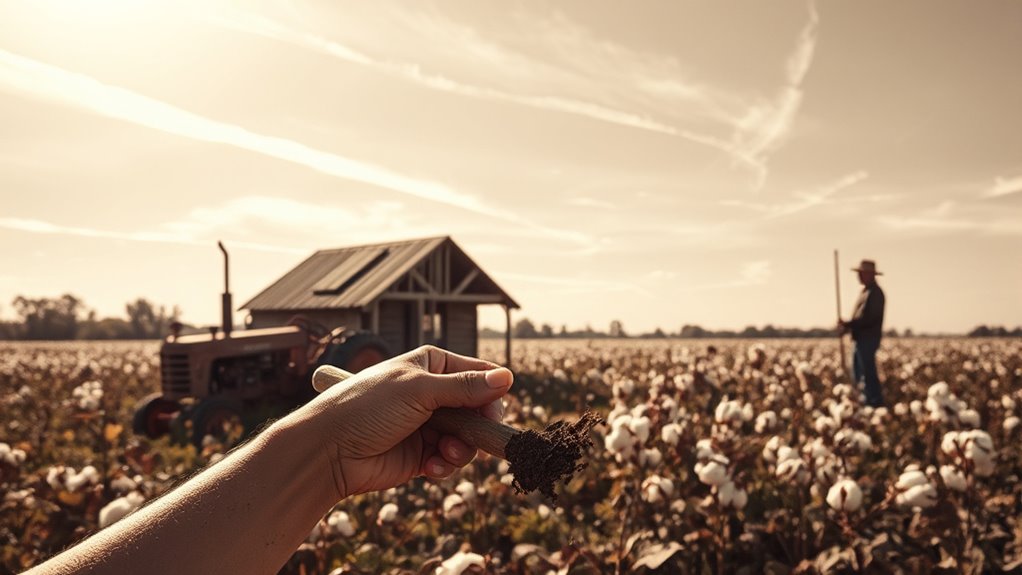
As the Civil War ended and the South faced the daunting task of rebuilding, tenant farming emerged as a practical solution to labor shortages, particularly in the Cotton Belt. This system developed rapidly, largely due to the economic necessity of mobilizing labor.
Many formerly enslaved people found themselves unable to manage farms independently, leading to the rise of sharecropping, where landowners provided essentials in exchange for a portion of the crop.
You'll notice that tenant farming varied regionally, with different rates across Georgia. While white tenants had been predominant before the war, the postbellum era saw significant demographic shifts, with African American tenants taking on a crucial role in this evolving agricultural landscape.
The Economic Structure of Tenant Farming

Understanding the economic structure of tenant farming reveals how this system relies on a delicate balance between landowners and tenants.
You'll notice that landowners provide land and sometimes capital, while you, the tenant, contribute labor and possibly some capital. Rent payments can come in various forms, including a fixed crop portion or cash.
Contracts vary significantly, influencing your tenure stability. With thin profit margins and market dependence, managing cash flow is crucial for survival. You may find yourself caught in debt cycles, using future crops as collateral.
Contracts play a pivotal role in tenant farming, affecting stability and cash flow management amidst market uncertainties.
Despite these challenges, tenant farming offers some economic stability, granting access to land and resources, though it often remains precarious amidst fluctuating market conditions.
Sharecropping: A Variant of Tenant Farming

Sharecropping, while a variant of tenant farming, emerged from unique historical circumstances that shaped its structure and function.
After the Civil War, many former slaves found themselves without capital, and landowners needed labor without upfront expenses. This system allowed you to work land you didn't own in exchange for a share of the crop, often half.
Landlords provided supplies on credit, leading to a cycle of debt due to high interest rates and unpredictable harvests. Unlike tenant farmers, who owned their tools and had more control over their crops, you faced restrictions on mobility and crop sales.
Despite offering some autonomy, sharecropping often trapped you in economic hardship, echoing the exploitative systems of the past.
Social Impacts of Tenant Farming Practices
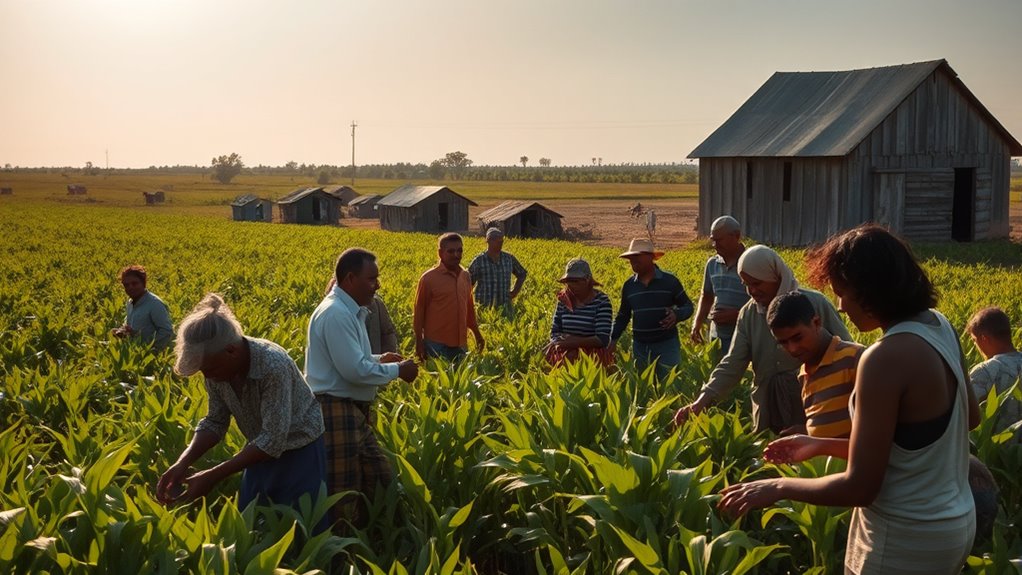
The legacy of sharecropping highlights the broader social impacts of tenant farming practices that extend beyond individual experiences.
You might notice that these practices create cycles of dependency, keeping tenant farmers in debt and limiting their economic mobility. Marginalized groups often find themselves particularly affected, facing discrimination and receiving poorer-quality land. This leads to ongoing racial disparities in land ownership and agricultural opportunities.
Additionally, tenant farmers struggle to invest in their communities due to financial constraints, weakening community cohesion. Labor conditions can be harsh, with limited protections that echo past exploitation.
While government interventions aim to address these issues, the need for stronger legal protections remains crucial for improving tenants' rights and overall social equity.
The Evolution of Tenant Farming After the Civil War
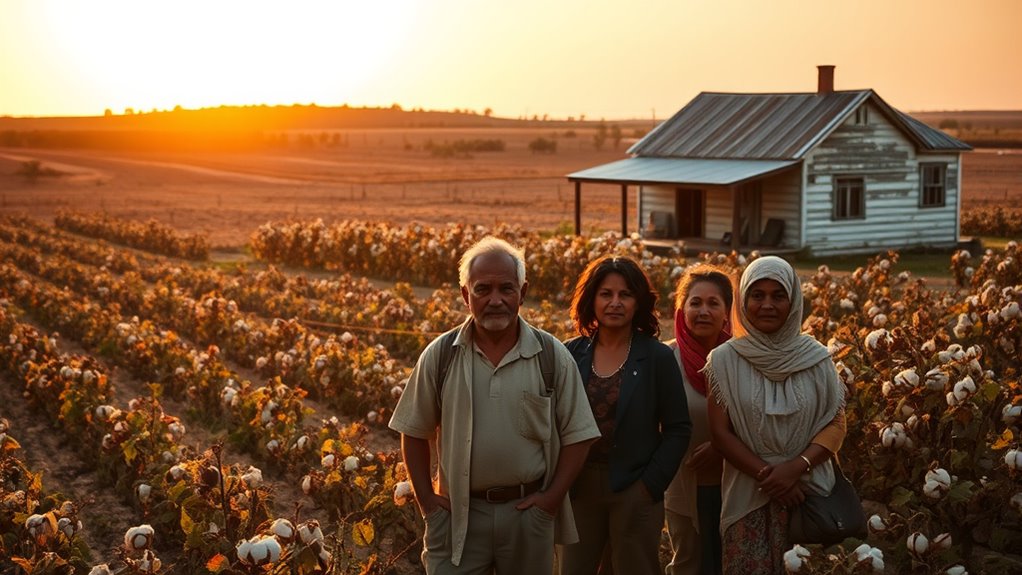
As the Civil War ended, the South faced a dramatically altered landscape, one where many former slaves and struggling white farmers found themselves without the resources to purchase land.
During the Reconstruction Era, efforts to establish freed slaves as landowners largely failed, paving the way for tenant farming to flourish. This system replaced the plantation model, where landowners provided resources in exchange for labor and a share of the crop.
Cotton and tobacco dominated tenant farming due to their profitability. However, low crop prices and high supply costs often trapped farmers in cycles of debt.
The relationships between landlords and tenants were frequently unstable, leading to poverty and uncertainty for many families who relied on this system for survival.
The Role of Tenant Farming During the Great Depression
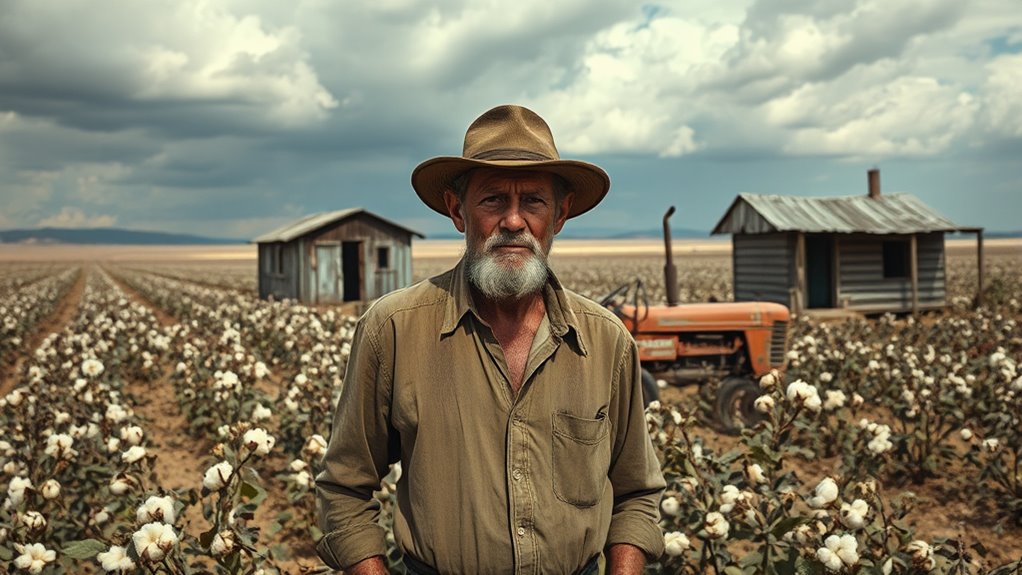
With the economic turmoil of the Great Depression, tenant farming faced even greater challenges than during the Reconstruction Era. Farm income plummeted by two-thirds, leaving tenant farmers struggling to survive. A global crop surplus caused prices to fall, while many farmers accumulated debt due to crop failures.
New Deal policies intended to aid farmers often benefitted landowners more, as they mechanized their operations and reduced the demand for tenant labor. This led to evictions and migration as many sought better opportunities in urban areas.
Racial disparities further complicated the situation, with Black farmers facing heightened exploitation. The combination of economic hardship, systemic inequities, and environmental disasters like the Dust Bowl deepened the struggles of tenant farmers during this difficult period.
Modern Challenges in Tenant Farming

While many might think of tenant farming as a relic of the past, modern tenant farmers face a host of challenges that threaten their viability.
Rising rent and input costs can strain your finances, especially during inflation. Access to credit can feel like climbing a mountain, as you may lack the collateral needed. Market fluctuations further complicate your income stability, leaving you vulnerable to crop failures and downturns.
Limited land control means you can't make long-term improvements, and restrictions from landlords can hinder your growth. Additionally, navigating new technologies can be tricky and costly, requiring digital skills you may not possess.
All these challenges make it tough to thrive in today's agricultural landscape.
Sustainable Farming Practices and Tenant Farming
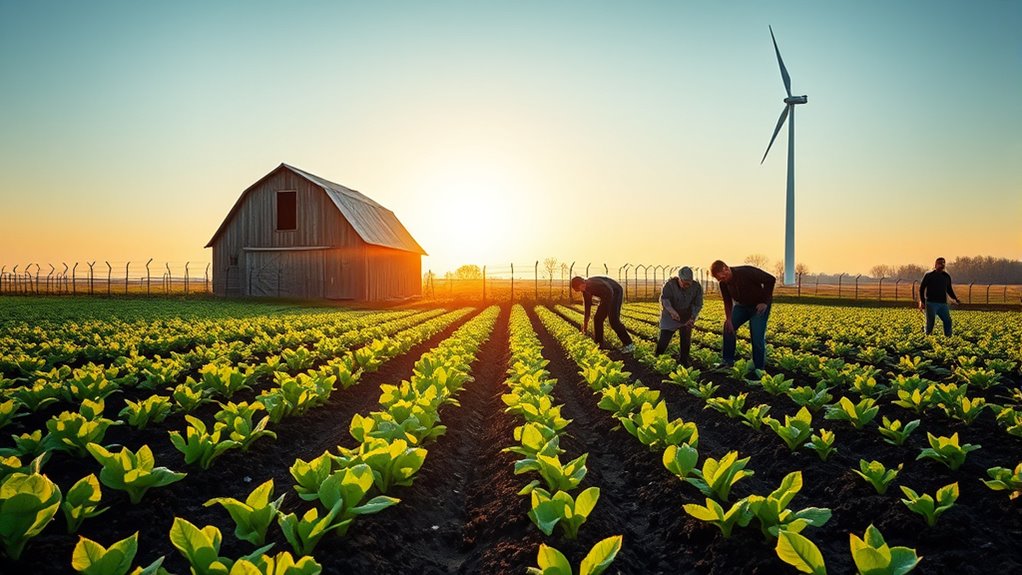
Sustainable farming practices can significantly benefit tenant farmers by promoting both environmental health and economic viability.
By implementing soil conservation techniques like conservation tillage, you reduce erosion and enhance organic matter. Crop rotation with small grains or hay improves soil health and biodiversity, while effective water management ensures clean water through grassed waterways and riparian buffers.
Reducing chemical use not only minimizes environmental impact but also boosts long-term income as organic crops often fetch premium prices. Aligning farming methods with personal values around wildlife and chemical use fosters a sense of stewardship.
Though challenges exist, such as financial constraints and knowledge gaps, the long-term benefits of sustainable practices can provide both profitability and a healthier ecosystem.
Comparative Analysis of Tenant Farming Systems
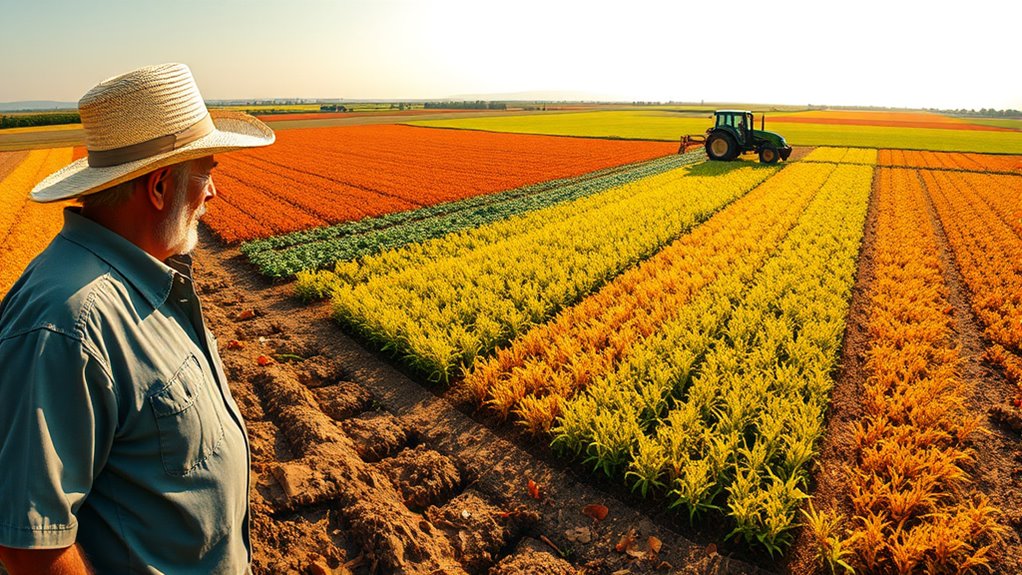
Understanding the various tenant farming systems is key to appreciating their impact on agricultural practices and the livelihoods of farmers.
Tenant farming systems differ significantly across regions, with cash leases providing flexibility while crop-share agreements allow for shared risk. Crop-share cash leases blend both approaches, offering a balance between fixed and variable payments.
Livestock-share leases introduce joint ownership, which can enhance collaboration. Each system has its own economic dynamics, influenced by market fluctuations and government policies.
Moreover, tenant farmers face unique challenges, such as access to capital and technological integration. By examining these differences, you can grasp how tenant farming adapts to local conditions, shaping both economic viability and farmer well-being in diverse agricultural landscapes.
The Legacy of Tenant Farming in Contemporary Rural Economies
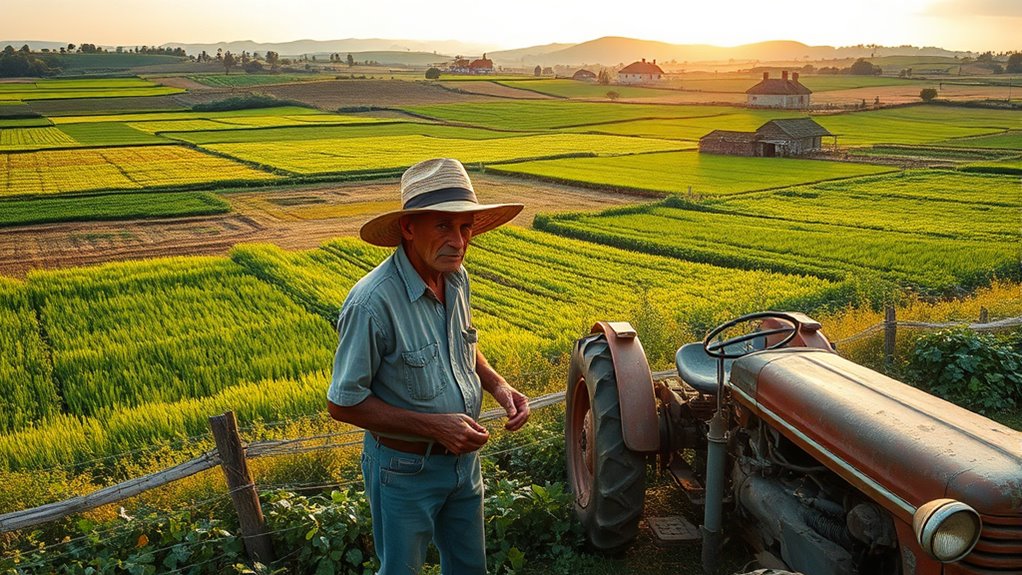
As tenant farming continues to shape contemporary rural economies, it plays a crucial role in providing opportunities for small-scale farmers who lack the resources to own land. This system fosters economic activity by generating jobs in cultivation and transportation while allowing farmers to adapt their crop choices to market demands.
With advancements in technology, you can now leverage improved irrigation and pest-resistant crops to enhance productivity. Moreover, modern regulations aim to protect tenant rights and ensure fair compensation for your improvements, addressing past inequalities.
While challenges remain, such as absentee landownership, tenant farming remains vital in creating economic stability and fostering local growth, helping you and others thrive in today's agricultural landscape.
Frequently Asked Questions
How Did Tenant Farming Affect Family Dynamics in Rural Communities?
Tenant farming significantly impacts family dynamics in rural communities. You'll notice families working together on the land, reinforcing bonds and shared responsibilities.
However, the economic pressures often strain relationships, as debt cycles create stress. Women often juggle both farm tasks and household duties, shaping family roles.
While some families find autonomy in their daily lives, the uncertainty of income can lead to additional work, altering traditional dynamics and pushing families to adapt continually.
What Role Did Education Play for Tenant Farmers and Their Families?
Education plays a crucial role for you and your family as tenant farmers. It can open doors to better job opportunities and help you manage your resources more effectively.
With access to education, you can improve your ability to negotiate with landowners and understand financial documents.
However, limited resources and time often hinder your family's educational pursuits, keeping you trapped in a cycle of economic instability and restricting your upward mobility.
How Did Tenant Farming Influence Local Political Structures?
Tenant farming significantly influenced local political structures by shifting power dynamics in rural areas.
As you engage with tenant farmers, you'll notice their growing political awareness, leading to demands for voting rights and fair tenancy regulations. This collective action often challenges entrenched interests, as landlords react defensively to protect their privileges.
What Were Common Living Conditions for Tenant Farmers?
As a tenant farmer, you often lived in cramped, run-down housing that lacked basic amenities.
Your home might've been a small, one-room shack, shared with family. Access to clean water and sanitation was limited, and medical care was often just a distant hope.
You relied on local stores for supplies, frequently falling into debt. Community support helped, but the overall environment was one of hardship, with little opportunity for improvement in your living conditions.
How Did Tenant Farmers Adapt to Technological Changes Over Time?
Imagine a river, constantly shifting with the flow of technology. You, as a tenant farmer, navigate its currents, adapting your boat to stay afloat.
When machinery arrives, you diversify your crops and seek off-farm jobs to harness new opportunities. You form cooperatives to strengthen your position against the tides of change.
While the landscape may shift, you learn to read the water, ensuring your survival amidst the technological whirlpool.
Conclusion
In the garden of agriculture, tenant farming stands as a resilient vine, intertwining the past with the present. You've seen how its roots dig deep into history, while its branches stretch toward modern challenges and sustainable practices. Like a farmer nurturing the soil, understanding tenant farming helps you cultivate a richer perspective on rural economies today. As you walk through this landscape, remember that every vine has a story, and each story shapes the harvest of our shared future.



